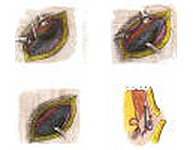Bardají Bofill Manel
Cirugía General Adultos
- Nuestros servicios
Hernioplasty according to the Lichtenstein technique
 The technique of hernioplasty without tension is based on the placement of a mesh as sufficient repair of the hernial defect, avoiding any other gesture not aimed at this purpose (the mesh is not used as a reinforcement of another previous suture).
The technique of hernioplasty without tension is based on the placement of a mesh as sufficient repair of the hernial defect, avoiding any other gesture not aimed at this purpose (the mesh is not used as a reinforcement of another previous suture).
2 types of techniques can be differentiated according to the type of prosthesis used:
Technique A
- Directions
- Direct or indirect primary inguinal hernias in adult men.
- Direct or indirect recurrent inguinal hernias with a defect greater than 3.5 cm in diameter.
- Technique
- Mesh
- The right size for the mesh should be 8 x 16 cm.
- The mesh should be sufficient to overlap about 2-3 cm above the Hesselbach triangle and about 1.5-2 cm above the pubic bone
- Fixation
- The lower edge of the mesh is fixed by a continuous suture to the inguinal or Poupart ligament to the plane of the deep inguinal orifice.
- The medial border is fixed with 2-3 loose stitches to the pubis partially covering it. Periodical stitches should be avoided.
- The mesh is incised on its outer edge to create two bands, the upper one of 2/3 and the lower one of 1/3. The two lower edges of both bands are joined by a single irresorbable point to the inguinal ligament.
- The upper edge of the mesh is attached by 4 loose stitches to the minor oblique muscle by resorbable suture.
- The rest of the lateral mesh to the crossing zone adapts about 2-3 cm below the aponeurosis of the greater oblique.
- Mesh
Technique B
- Directions
- Direct or indirect recurrent inguinal hernias with a defect less than 3.5 cm in diameter.
- Primary and recurrent crural hernias.
- Technique
- Mesh: A mesh strip of 2 x 10 cm is wound with a clamp forming a firm and solid plug.
- Fixation: Once the sac is found, only the adjacent tissues are dissected by about 3-5 mm to allow the plug to be fixed with loose stitches to the periphery of the defect.
Contact us
Centro Médico Teknon
Bardají Bofill Manel
Consultorios Marquesa (despacho 34)
Marquesa de Vilallonga, 12
08017 Barcelona
93 290 64 34 / 93 417 23 02 (Fax)
Schedules
| Morning | Afternoon | |
|---|---|---|
| Monday | 09.00 - 13.00 h | 16.00 - 20.00 h |
| Tuesday | 09.00 - 13.00 h | 16.00 - 20.00 h |
| Wednesday | 09.00 - 13.00 h | 16.00 - 20.00 h |
| Thursday | 09.00 - 13.00 h | 16.00 - 20.00 h |
| Friday | 09.00 - 13.00 h | 16.00 - 20.00 h |















